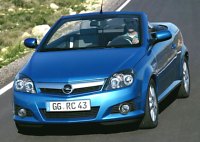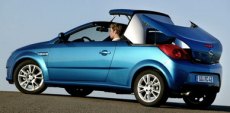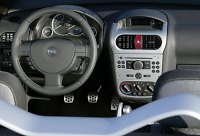|
 3
years ago, Peugeot stunned the world by putting the little 206CC into
production.
Before it, no one would have believed a car so small and so cheap can
be
equipped with an electric retractable metal roof - the technology once
reserved for Mercedes. The retractable roof was made by French
coach-builder
Heuliez instead of Peugeot itself. Now Opel also employs Heuliez to
help
realizing its first retractable roof car - the new Tigra. Not only the
roof, but the whole Tigra is built by Heuliez in France. 3
years ago, Peugeot stunned the world by putting the little 206CC into
production.
Before it, no one would have believed a car so small and so cheap can
be
equipped with an electric retractable metal roof - the technology once
reserved for Mercedes. The retractable roof was made by French
coach-builder
Heuliez instead of Peugeot itself. Now Opel also employs Heuliez to
help
realizing its first retractable roof car - the new Tigra. Not only the
roof, but the whole Tigra is built by Heuliez in France.
You
may remember the first generation Tigra was renowned for show-car-like
cute styling. The second generation loses somewhat that refreshing
feeling.
It is bold, edgy and more aggressive, although mechanical-wise it
remains
to be a warm rather than hot coupe - power comes from the existing
125hp
1.8-litre Ecotec 16V or a 90hp 1.4-litre 16V Twinport (variable intake
manifold). The car is built on the Corsa / Meriva platform and
incorporates
some parts from new Astra. Like its predecessor, it is a front-drive
little
car with unsophisticated mini-car suspensions.
 Highlight
is the roof mechanism. Unlike 206CC, the Tigra is strictly a 2-seater.
That’s not bad, as the rear seats of 206CC are virtually a joke.
Sacrificing
the dog seats liberates space to accommodate the metal roof, which
folds
almost vertically into the body. When the roof is stored, there is 250
litres of luggage space. This increases to 440 litres with the roof up.
These are significantly more than Peugeot's 175 / 410 litres. Moreover,
the Tigra has 70 litres of additional space behind the front seats,
very
useable for storing soft bags and briefcases. Highlight
is the roof mechanism. Unlike 206CC, the Tigra is strictly a 2-seater.
That’s not bad, as the rear seats of 206CC are virtually a joke.
Sacrificing
the dog seats liberates space to accommodate the metal roof, which
folds
almost vertically into the body. When the roof is stored, there is 250
litres of luggage space. This increases to 440 litres with the roof up.
These are significantly more than Peugeot's 175 / 410 litres. Moreover,
the Tigra has 70 litres of additional space behind the front seats,
very
useable for storing soft bags and briefcases.
 The
Tigra is a car made to budget. You won't expect Audi-grade quality, but
it is reasonably well-built. It suffers no fit and finish disaster like
Citroen Pluriel and outdated interior like 206CC or Ford StreetKa, nor
the cramped cabin of Daihatsu Copen and Toyota MR-S. Body panels are
well
assembled, with some stylish features such as the alloy-effect rollover
bars behind the seats. The Corsa-based dashboard is solidly screwed
together,
if not very stylish. Like other retractable roof cars, the top edge of
windscreen is closer to the driver's head than conventional convertible
in order to reduce the area of the roof. This has some negative effect
on the airy feel, but it does manage air flow very well. The cabin is
generally
free of turbulence. Such a high level of refinement is new to this
price
range. The
Tigra is a car made to budget. You won't expect Audi-grade quality, but
it is reasonably well-built. It suffers no fit and finish disaster like
Citroen Pluriel and outdated interior like 206CC or Ford StreetKa, nor
the cramped cabin of Daihatsu Copen and Toyota MR-S. Body panels are
well
assembled, with some stylish features such as the alloy-effect rollover
bars behind the seats. The Corsa-based dashboard is solidly screwed
together,
if not very stylish. Like other retractable roof cars, the top edge of
windscreen is closer to the driver's head than conventional convertible
in order to reduce the area of the roof. This has some negative effect
on the airy feel, but it does manage air flow very well. The cabin is
generally
free of turbulence. Such a high level of refinement is new to this
price
range.
After
chopping off the roof, the chassis received numerous reinforcements at
underbody, sills and pillars. The result is remarkable stiffness by the
standard of this class. Unless you push it very hard, there is hardly
any
shake and creak. The suspensions are set lower and stiffer than the
hottest
Corsa GSi, so the Tigra handles competently, if not inspiringly. Its
steering
takes 3.0 turns from lock to lock, so you won't feel the same sharpness
as a really exciting roadster like MX-5 and MR-S. Gearchange can't
match
the Japanese too, especially the notchy gearbox coupled to the 1.8
engine.
 Both
engines are unremarkable. The 90hp 1.4 is eager and reasonably refined
but lacks power to pull the 1235kg kerbweight. The Tigra is at least
100kg
heavier than rivals, and in some cases up to 200kg! this must blame the
complex roof, chassis reinforcements and the iron-block engine. No
wonder
the 1.4-litre Tigra takes almost 12 seconds to accelerate from rest to
60mph. The 1.8-litre engine adds another 35 horsepower and cut 0-60mph
time to 9 seconds, but it is noisy and reluctant at higher rev, failing
to match the refined manner of the chassis. Both
engines are unremarkable. The 90hp 1.4 is eager and reasonably refined
but lacks power to pull the 1235kg kerbweight. The Tigra is at least
100kg
heavier than rivals, and in some cases up to 200kg! this must blame the
complex roof, chassis reinforcements and the iron-block engine. No
wonder
the 1.4-litre Tigra takes almost 12 seconds to accelerate from rest to
60mph. The 1.8-litre engine adds another 35 horsepower and cut 0-60mph
time to 9 seconds, but it is noisy and reluctant at higher rev, failing
to match the refined manner of the chassis.
The
point is, although the Tigra looks like an exciting roadster, it is
actually
a refined open-top mini car. People looking for sparkling performance
and
sharp handling are not going to be satisfied with Tigra. But if you
look
for a personal transport with good look, quality, refinement and
practicality
plus an attractive retractable roof, and if you can afford only a
fraction
the price and running cost of a Mercedes SLK, this is the car for you.
|